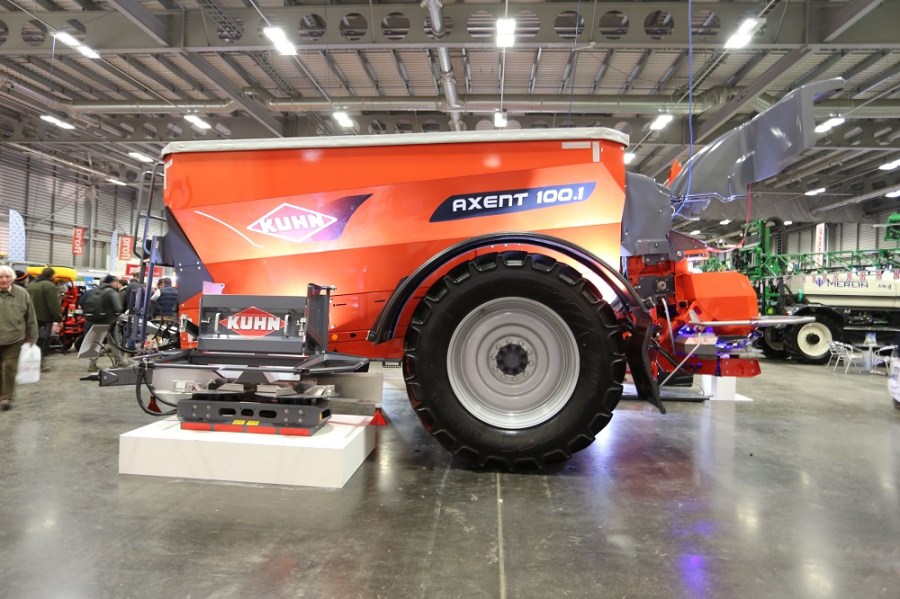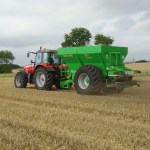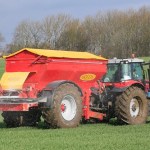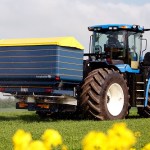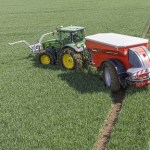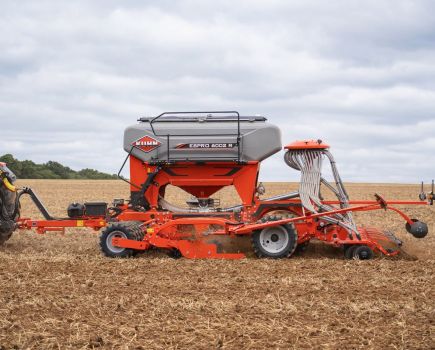Precision application of large amounts of fertiliser has become a priority for many farmers and contractors. CPM takes a look at a few of the options.
There’s increasing demand for big capacity trailed models that offer the same level of accuracy and control as their mounted counterparts.
By Jane Brooks
In recent years, fertiliser spreader development has been led by the use of sensor and map-based variable rate technologies to determine fertiliser requirements. Covering the ground quickly and accurately while monitoring progress has also seen demand grow for larger capacity spreaders with wider working widths.
There are several mounted fertiliser spreaders on the market that’ll carry up to 4000kg. Sulky’s top of the range X50 mounted spreader has a working width of up to 50m and maximum hopper capacity of 4000 litres. It uses Sulky’s patented Epsilon spreading system.
The X50 is also available with ISOBUS and the firm’s Econov section-control system. Sulky says Econov is the only section shut-off system that spreads to the curve, which eliminates over and under spreading on headlands.
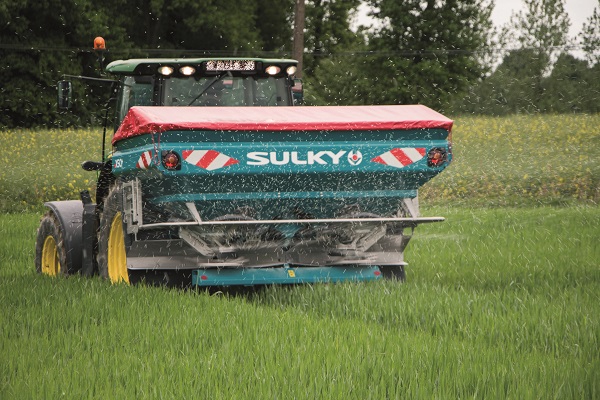
Sulky’s top of the range X50 mounted spreader has a working width up to 50m and maximum hopper capacity of 4000 litres.
It includes the Vision WPB on-board weighing device, new Tribord 3Di system (borders), Ready to Spread (automated adjustment settings from Fertitest) and the Matrix 840 GS guidance bar.
Using GPS technology, internet links and automation, Sulky says the system enables crops to be accurately fertilised over entire plots of land, even when irregular in shape.
Last year Sulky UK also launched a hydraulically driven, self-winding rolling cover for its X40+ and X50+ spreaders. There’s also a hydraulically operated border deflector to give added protection to field margins.
The new cover can be operated manually or remotely from the tractor cab, simplifying loading operations, which is particularly useful when working alone.
The half-moon shaped cover winds from the centre, which Sulky says makes the underside of the cover and inside the hopper less likely to be contaminated with water, mud or other debris.
- Essex based contractors R and M Simeon solved the problem of large-scale application by using a Gustrower GDK6000 trailed lime and fertiliser spreader
- The Bredal F10 has full IsoBus control with weigh cells together with section control and variable-rate spreading.
- The Bogballe M6W has a hopper capacity of 6000kg and a spread width of 12-42m making it the highest capacity linkage-mounted spreader on the market.
- A sophisticated machine, the Axent 100 provides all the precision of its stable mates in Kuhn’s mounted range.
Smart technology
The Amazone ZA-TS series now feature the optional Argus Twin spread-control system, available on all mechanically or hydraulically driven spreaders in the range. Each disc has radar sensors mounted above each unit, which monitor the spread pattern.
Fertiliser delivery is automatically adjusted if there are changes in the set spread pattern, possibly caused by working on slopes, poor fertiliser quality or braking. With no moving parts, Amazone says the system should be robust and maintenance-free. Argus technology operates when border spreading or in section control.
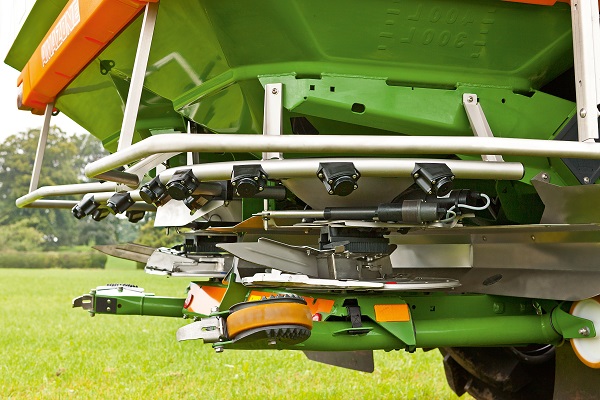
Amazone’s ZA-TS series now features the optional Argus Twin spread control system, with radar sensors mounted above each disc unit to monitor the spread pattern.
The ZA-TS Ultra Frame model will carry weights of up to 4500kg and has category III linkage.
Another feature Amazone may have available in 2017 is their EasyCheck smartphone App, which makes checking the fertiliser distribution pattern extremely simple, says the company. Instead of the normal collecting trays, lightweight rubber collecting mats (40×60 cm) are laid out in the tramline at the correct spacing.
Subsequently the EasyCheck App needs to be calibrated by taking a picture of the specific fertiliser on the mat. After spreading over the laid out collecting mats, the number of granules that have been collected on the 16 mats are photographed on a Smartphone.
The App automatically compares how much fertiliser has been collected on an individual row of mats and puts the result of each mat row in a ratio.
On the basis of this evaluation, the accuracy of the spread pattern can be easily checked. In cases where an optimum spreading result isn’t achieved, the App automatically suggests a readjustment of the spreading disc speed or of the delivery system on the ZA-TS or, on the ZA-V, a change in the throwing vane position.
Amazone says the EasyCheck app, digital test kit, will allow a check on the lateral distribution of the fertiliser to be carried out quickly and simply, directly in the field. The collecting mats shouldn’t take up much space and can be easily transported with the spreader or in the tractor.
Mounted monster
The Bogballe M6W has a hopper capacity of 6000kg and a spread width of 12-42m and its Danish makers claim it’s the biggest linkage-mounted spreader on the market. Designed mainly for tracked tractors, it’s pto powered. Obviously, some heavy-duty lift capacity is needed, but it would probably be able to travel across ground earlier in the season than something on wheels.
The Bogballe differs from other designs in that the discs spin inwards, throwing fertiliser in a semi-circle. So even if one side is shut off the spread pattern remains the same. This means that both discs have to be adjusted to change the pattern at either side.
Bogballe’s Section Control Dynamic system is available for M series spreaders. Shutters operate in eight linear steps, which simultaneously adjust the quantity and move the spread pattern individually on both sides of the spreader to improve accuracy. The SCD is available as an option, with Calibrator Zurf or ISOBUS, and can be operated either manually or automatically. Bogballe says that its standard system is suitable for spreading up to 24m and recommend SCD for greater bout widths.
The machines’ UK distributors are Keith Rennie Machinery, who also offer Calibration Free, which is a tablet-based smart App for GPS-controlled headland and section-control management. It’s a “plug-and-play” system, which consists of a GPS antenna with receiver and a wireless i-Zurf communication module, which is connected to the spreader controller.
Once the i-Zurf is connected to Calibrator Zurf it establishes a WiFi connection in a 5m zone around the spreader. In this WiFi zone, the spreader functions can be operated via an Android tablet from both inside and outside the cab.
Calibrator Free is available for all KRM’s weigh-cell spreaders with Calibration Zurf. The free App can be downloaded from Google Play and a demo version runs directly on a tablet without any further equipment. For 2017, the free App also includes variable-rate application to follow pre-prepared fertiliser application maps.
Going large
Rear lift capacity is the determining factor when it comes to a mounted fertiliser spinner. The only way to further increase capacity is to use a trailed machine.
Manufacturers have recognized that there’s increasing demand for big capacity trailed models that offer the same level of accuracy and control as their mounted counterparts.
In the past few years, producers and contractors, particularly those who spread a lot of nitrogen, have been demanding options, such as section control, in a high capacity trailed spreader.
The KRM Bredal F8 and F10 trailed models are competitively priced and have proved popular since their launch last year. But with their Axent 100.1, Kuhn have really thrown down the gauntlet to other manufacturers. It’ll be interesting to see where the next couple of years take the high-tech trailed-spreader market.
Kuhn launched the trailed Axent 100.1 spreader at this year’s LAMMA show. A sophisticated machine, it provides all the precision of its stable mates in Kuhn’s mounted range. It has a hopper capacity of 9400 litres and uses two inter-changeable spreading modules to deliver either granular or powdered material. It also offers variable-rate spreading and automatic section control.
Using the same technology as Kuhn’s Axis range of twin disc spreaders, the hydraulically driven Axis PowerPack precisely spreads granular fertilisers across working widths of 18-50m. Kuhn’s EMC (Electronic Mass Control) system is used to continuously adjust the spreading rate across the machine’s entire width. This is achieved by constantly measuring the torque on each spreading disc and adjusting the flow rate on a second-by-second basis.
The Axis PowerPack also uses Kuhn’s Co-axial Distribution Adjustment system (CDA) in conjunction with GPS and variable-rate mapping to reduce or close sections of the spread pattern.
The Lime PowerPack uses 700mm spreading discs specifically designed to spread powdered soil conditioners such as lime and pellet fertilisers to a distance of 15m. Kuhn says switching the spreading modules is a simple procedure that can be completed in less than 10mins on the farm.
A steering axle is also available. It can also be specified with four weigh cells to improve spreading calibration.
Why calibrate?
The National Spreader Testing Scheme has been created to promote the efficient use of fertiliser. Additional benefits of annual testing include meeting cross compliance and NVZ regulation. Several companies offer annual testing by suitably qualified operatives.
To check uniformity of spread pattern, trays should be used to produce a coefficient of variation across the full width of spread.
A coefficient of variation above 20% will lead to visible striping in crops. As this figure increases from 20-30%, crop yields in wheat and oilseed rape for example, are likely to be reduced.
Granule size, density and granular crush strength can affect spreader accuracy. Even different dates of manufacture can lead to very slight differences in consistency. More information and a list of NSTS sprayer and spreader test centres is available at www.nsts.org.uk.
Bredal benefits for Oxon grower
The KRM Bredal F8 and F10 trailed spreaders were launched at last year’s LAMMA. Oxon-based farmer Duncan Jack, who’s used Bredal spreaders for some years, bought an F10 model shortly after the show. This has full ISOBUS control with weigh cells and gives him section control and variable-rate spreading.
“The accuracy and headland control were the reasons we went for the F10,” he says. “The actual machine alters the rate very well and does the job properly, but the ISOBUS computer doesn’t tell you as quickly. We understand it’ll get sorted shortly with a software update.”
The F10 spreads mainly granulated urea and other such products and so far, has spread about 2000ha. Duncan Jack says it’s standing up to the work very well. “The spread pattern is all we want it to be and it’ll hold around 6t of urea. We use it on a Fendt 724 and have no problems there.
“We only spread up to 24m as small fields and hilly terrain dominate the area. There’s no trouble setting it up from tray tests. Section control was one of its main attractions. We cart our inputs to it with a high lift trailer, so our operator doesn’t have to stop spreading.
“We use variable-rate application, but are very old fashioned and do it ourselves. Basically, the operator sits in the cab with the map so he knows what to put on and where. We use P and K and also put on lime granules as you can’t run lime through a twin belt machine.”
The Bredal F series has twin floor belts, each individually controlled by hydraulic motors, allowing variable feed to each spreading disc. Control can be through GPS and ISOBUS from the tractor’s terminal. An alternate Müller control unit is available if the tractor isn’t ISOBUS ready.
The machine has weigh cells and is fitted with the Bredal headland gear system. Automatic stop/start and section control is a standard feature.

